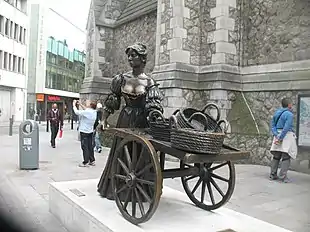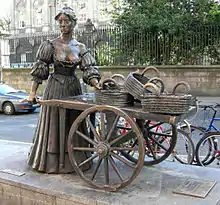Molly Malone
"Molly Malone" (also known as "Cockles and Mussels" or "In Dublin's Fair City") is a popular song set in Dublin, Ireland, which has become its unofficial anthem.


A statue representing Molly Malone was unveiled on Grafton Street by then Lord Mayor of Dublin, Ben Briscoe, during the 1988 Dublin Millennium celebrations, when 13 June was declared to be Molly Malone Day. In July 2014, the statue was relocated to Suffolk Street, in front of the Tourist Information Office, to make way for Luas track-laying work at the old location.
History
The song tells the fictional tale of a fishwife who plied her trade on the streets of Dublin and died young, of a fever. In the late 20th century a legend grew up that there was a historical Molly, who lived in the 17th century. She is typically represented as a hawker by day and part-time sex-worker by night.[1] In contrast she has also been portrayed as one of the few chaste female street-hawkers of her day.
There is no evidence that the song is based on a real woman, of the 17th century or any other time. The name "Molly" originated as a familiar version of the names Mary and Margaret. While many such "Molly" Malones were born in Dublin over the centuries, no evidence connects any of them to the events in the song.[1][2] Nevertheless, the Dublin Millennium Commission in 1988 endorsed claims made for a Mary Malone who died on 13 June 1699, and proclaimed 13 June to be "Molly Malone Day".[1]
The song is not recorded earlier than 1876, when it was published in Boston, Massachusetts.[3] Its placement in the section of the book titled "Songs from English and German Universities" suggests an Irish origin.[4] It was also published by Francis Brothers and Day in London in 1884 as a work written and composed by James Yorkston, of Edinburgh, with music arranged by Edmund Forman. The London edition states that it was reprinted by permission of Kohler and Son of Edinburgh, implying that the first edition was in Scotland, though no copies of it have been found.[5][6] According to Siobhán Marie Kilfeather, the song is from the music hall style of the period, and while one cannot wholly dismiss the possibility that it is "based on an older folk song", "neither melody nor words bear any relationship to the Irish tradition of street ballads." She calls the story of the historical Molly "nonsense". The song is in a familiar tragicomic mode popular in its period, and probably influenced by earlier songs with a similar theme, such as Percy Montrose's "Oh My Darling, Clementine", which was written in about 1880.
A variant, "Cockles and Mussels", with some different lyrics, appeared in Students' Songs: Comprising the Newest and Most Popular College Songs As Now Sung at Harvard, Yale, Columbia, ... Union, Etc in 1884.[7]
A copy of Apollo's Medley, dating from around 1790, published in Doncaster and rediscovered in 2010, contains a song referring to "Sweet Molly Malone" on page 78 that ends with the line "Och! I'll roar and I'll groan, My sweet Molly Malone, Till I'm bone of your bone, And asleep in your bed." Other than this name and the fact that she lives in Howth, near Dublin, this song bears no resemblance to Molly Malone.[8] The song was later reprinted in the collection The Shamrock: A Collection of Irish Songs (1831) and was published in The Edinburgh Literary Journal that year with the title "Molly Malone".[9]
Some elements of the song appear in several earlier songs. A character named Molly Malone appears in at least two other songs. The song "Widow Malone," published as early as 1809, refers to the title character alternately as "Molly Malone," "Mary Malone" and "sweet mistress Malone".[4] An American song, "Meet Me Miss Molly Malone", was published as early as 1840.[4] The song "Pat Corney's Account of Himself", published as early as 1826,[10] begins, "Now it's show me that city where the girls are so pretty" and ends, "Crying oysters, and cockles, and Mussels for sale."[4] During the 19th century, the expression "Dublin's fair city" was used regularly in reference to Dublin, and the phrase "alive, alive O" is known to have been shouted by street vendors selling oysters, mussels, fish and eels.[4]
Lyrics
- In Dublin's fair city,
- Where the girls are so pretty,
- I first set my eyes on sweet Molly Malone,
- As she wheeled her wheel-barrow,
- Through streets broad and narrow,
- Crying, "Cockles and mussels, alive, alive, oh!"
- "Alive, alive, oh,
- Alive, alive, oh,"
- Crying "Cockles and mussels, alive, alive, oh".
- She was a fishmonger
- But sure 'twas no wonder
- For so were her father and mother before
- And they each wheel'd their barrow
- Through streets broad and narrow
- Crying "Cockles and mussels alive, alive oh!"
- (chorus)
- She died of a fever,
- And no one could save her,
- And that was the end of sweet Molly Malone.
- But her ghost wheels her barrow,
- Through streets broad and narrow,
- Crying, "Cockles and mussels, alive, alive, oh!"
- (chorus) ×2[11]
"Cockles and Mussels" in Students' Songs (1884)
- In Dublin City where the girls they are so pretty,
- 'Twas there I first met with sweet Molly Malone;
- She drove a wheel-barrow, thro' streets broad and narrow,
- Crying "Cockles and mussels, alive, all alive!"
- Alive, alive-o! Alive, alive-o!
- Crying "Cockles and mussels, alive, all alive!"
- She was a fish-monger and that was the wonder,
- Her father and mother were fishmongers too;
- They drove wheelbarrows thro' streets broad and narrow,
- Crying "Cockles and mussels, alive, all alive!"
- (chorus)
- She died of the fever, and nothing could save her,
- And that was the end of sweet Molly Malone;
- But her ghost drives a barrow thro' streets broad and narrow,
- Crying "Cockles and mussels, alive, all alive!"
- (chorus)
"Molly Malone" in Apollo's Medley (1791)
- By the big Hill of Howth,
- That's a bit of an Oath,
- That to swear by I'm loth,
- To the heart of a stone,
- But be poison my drink,
- If I sleep snore or wink,
- Once forgetting to think,
- Of your lying alone,
- Och it's how I'm in love,
- Like a beautiful dove,
- That sits cooing above,
- In the boughs of a tree;
- It's myself I'll soon smother,
- In something or other,
- Unless I can bother,
- Your heart to love me,
- Sweet Molly, Sweet Molly Malone,
- Sweet Molly, Sweet Molly Malone
- I can see if you smile,
- Though I'm off half a mile,
- For my eyes all the while,
- Keep along with my head,
- And my head on must know,
- When from Molly I go,
- Takes his leave with a bow,
- And remains in my stead,
- (chorus)
- Like a bird I could sing,
- In the month of the spring,
- But it's now no such thing,
- I'm quite bothered and dead,
- Och I'll roar and I'll groan,
- My sweet Molly Malone,
- Till I'm bone of your bone, [a reference to Genesis 2:23]
- And asleep in your bed
- (chorus)[12]
Statue
Molly is commemorated in a statue commissioned by Jurys Hotel Group and designed by Jeanne Rynhart, erected to celebrate the city's first millennium in 1988. Originally placed at the bottom of Grafton Street in Dublin, this statue is known colloquially as "The Tart with the Cart" or "The Trollop With The Scallop(s)". The statue portrays Molly as a busty young woman in 17th-century dress. Her low-cut dress and large breasts were justified on the grounds that as "women breastfed publicly in Molly's time, breasts were popped out all over the place."[2][13]
The statue was later removed and kept in storage to make way for the new Luas tracks.[14] In July 2014, it was placed outside the Dublin Tourist Office on Suffolk Street.
In popular culture
Fair City derives its title from the opening line of the song: "In Dublin's fair city, where the girls are so pretty..."[15]
In the movie A Clockwork Orange, a drunk tramp sings Molly Malone in a tunnel before getting assaulted by the droogs.[16]
Recordings
Artists who have recorded versions of Molly Malone include The Dubliners,[17] Heino, Danny Kaye, Pete Seeger, Alfred Deller, The Limeliters, Frank Harte, Sinéad O'Connor, Johnny Logan, Ian McCulloch, Paul Harrington, Damien Leith, Burl Ives, Patty Gurdy and U2.
Bing Crosby and Rosemary Clooney recorded an updated version of the song titled "The Daughter of Molly Malone" on their album That Travelin' Two-Beat (1965). Crosby also sang the song on the album A Little Bit of Irish recorded in 1966.
Operatic baritone Bryn Terfel has recorded a highly operatic version of the tune, sung in a somewhat upbeat fashion.
Versions of the song have also been recorded in Russian (as Душа моя, Молли or "Molly, my soul"), French, and in Dutch (as "kokkels en mossels").
See also
References
- Siobhán Marie Kilfeather, Dublin: a cultural history, Oxford University Press US, 2005, p. 6.
- "Irish Historical Mysteries: Molly Malone". homepage.eircom.net.
- Waite, Henry Randall (1876). Carmina Collegensia: A Complete Collection of the Songs of the American Colleges, with Selections from the Student Songs of the English and German Universitys. Ditson. p. 73.
- Brown, Peter Jensen. "Molly Malone, Molly Mogg and a Missing Link – the Fishy History and Origins of "Cockles and Mussels"". Early Sports 'n' Pop-Culture History Blog.
- "Cockles and Mussels (Molly Malone)". Folkinfo.org (quoting book by Sean Murphy). 2002. Archived from the original on 19 July 2011. Retrieved 22 August 2007.
- Name, Your Museum. "Cockles and Mussels or, Molly Malone / Written and Composed by James Yorkston ; Arranged by Edmund Forman - ECCI00029782". www.charliechaplinarchive.org.
- Hills, William H. (William Henry) (7 March 1884). "Student's songs : comprising the newest and most popular college songs as now sung at Harvard, Yale, Columbia ... Union, etc". Cambridge, Mass. : M. King – via Internet Archive.
- Maev Kennedy (18 July 2010). "Tart with a cart? Older song shows Dublin's Molly Malone in new light". The Guardian.
- "The Edinburgh Literary Journal: Or, Weekly Register of Criticism and Belles-lettres". Constable and Company. 8 November 1831 – via Google Books.
- The Universal Songster: or, Museum of Mirth. London: John Fairburn. 1826. p. 19.
- Yorkston, James (1998). "Molly Malone lyrics". Retrieved 6 October 2008.
- The Edinburgh Literary Journal: Or, Weekly Register of Criticism and Belles Lettres, 5, 1831, p. 350, retrieved 31 March 2015
- "Molly Malone Statue Unveiled. | Irish Photo Archive". irishphotoarchive.photoshelter.com. Retrieved 29 December 2020.
- Flaherty, Rachel (1 May 2014). "Molly Malone statue wheeled away to make way for Luas". The Irish Times.
- Sheehan, Helena (2004). The Continuing Story of Irish Television Drama. Dublin: Four Courts Press. pp. 39-57. ISBN 1-85182-689-0.
- A Clockwork Orange (1971) - IMDb, retrieved 15 December 2020
- "The Dubliners: Discography – Live 40 Years Reunion". It's the Dubliners. Retrieved 12 April 2017.
External links
| Wikisource has original text related to this article: |
 Media related to Molly Malone at Wikimedia Commons
Media related to Molly Malone at Wikimedia Commons- Lyrics with chords
- An article about Molly Malone